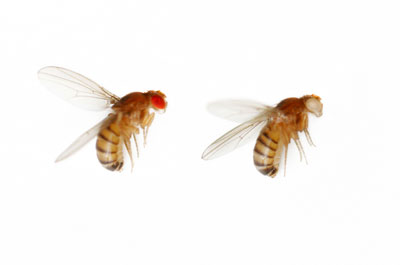Jun. 24, 2021 Research Highlight Biology
Age-related stem cell dysfunction linked to eye-color gene
A gene that was assumed mainly to determine eye color in fruit flies also affects gut stem cells, and could play a role in colorectal cancer in people
 Figure 1: The white gene is a sex-linked gene that causes fruit flies to have white eyes rather than red ones (wild type). RIKEN researchers have now found that it also drives aging-related defects in intestinal stem cells. © MARTIN SHIELDS/SCIENCE PHOTO LIBRARY
Figure 1: The white gene is a sex-linked gene that causes fruit flies to have white eyes rather than red ones (wild type). RIKEN researchers have now found that it also drives aging-related defects in intestinal stem cells. © MARTIN SHIELDS/SCIENCE PHOTO LIBRARY
In a discovery with implications for colorectal cancer in humans, RIKEN geneticists have found that a gene that determines eye color in fruit flies also plays a role in the tendency of gut stem cells to proliferate out of control with aging1.
Since its discovery by Nobel Prize laureate Thomas Hunt Morgan in 1910, the white gene, which controls eye color in fruit flies (Fig. 1), has been studied for more than a century. It is used as an easily identifiable marker in genetic experiments using fruit flies since any defects arising from mutations in the gene are assumed to be mild enough not to greatly impact other aspects of biology under investigation.
Now, working with fruit flies, a team led by developmental cell biologist Sa Kan Yoo of the RIKEN Center for Biosystems Dynamics Research has found a previously unsuspected role of the gene—it also drives aging-related defects in intestinal stem cells (ISCs) through changes in the metabolism of nutrients.
An analogous gene is expressed in the human gut, where it could be contributing to the development of colorectal cancer, one of the most common tumor types in the world.
More immediately, the findings could have major implications for the large community of researchers who study fruit flies—if white contributes substantially to gut metabolism, then that could skew results in studies related to physiology, energetics and behavior where it is used as a genetic marker. “I predict our study will have a huge impact on the fly-research community, especially scientists using fruit flies to investigate metabolism,” says Yoo.
Yoo’s team stumbled upon the link between white and ISC function in a routine screen of flies from various genetic backgrounds. While looking for differences in stem-cell proliferation induced by aging, they found that flies with white mutations stood out from the rest. In those flies, levels of white expression in ISCs went up as the insects got older. With more of the corresponding protein, the stem cells took in more tetrahydrofolate, a derivative of vitamin B9 that helps fuel the kind of runaway cell growth that, in humans at least, tends to bring about colon polyps and eventually cancer.
Genetically blocking white activity in ISCs prevented this kind of cellular dysregulation and increased the lifespan of flies. If a similar phenomenon occurs in human ISCs—and Yoo emphasizes that further investigation is still needed—drugs that inhibit the process could help to maintain gut health and prevent cancer from taking root.
Related contents
- Changes in nutrient storage and metabolism help fruit flies reach maturity
- Dietary amino acid determines the fate of cancer cells
- Proteins enable tendons and muscles of fruit flies to develop in sync
Reference
- 1. Sasaki, A., Nishimura, T., Takano, T., Naito, S. & Yoo, S. K. white regulates proliferative homeostasis of intestinal stem cells during ageing in Drosophila. Nature Metabolism 3 546–557 (2021). doi: 10.1038/s42255-021-00375-x
